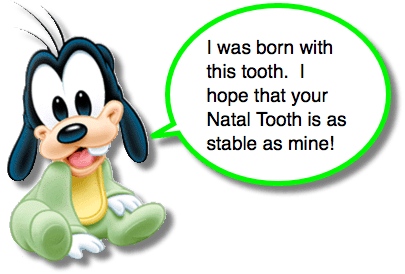Natal and Neonatal Teeth
For Emergency Physicians, neonatal “issues” often fall into one of two categories: 1) terrible, life-threatening disasters (ex, Necrotizing Enterocolitis, HSV, Congenital Heart Disease) and (2) I have no clue what that is, but it seems like your Primary Care Provider can help you with that (ex, feeding problems, rashes). While those two classifications may be appropriate for most cases, neonates are tricky and often the boundaries between those two groups are blurred. Is that neonates vomiting typical spit up, or a sign of Pyloric Stenosis or Intussusception or Malrotation?
Additionally, neonates can also present with unique problems that are not commonly encountered, but are necessary for us to be familiar with (ex, Umbilical Cord Issues). One interesting problem that might seem to be an easy issue to simple refer, but may actually benefit from us knowing a little more about it is Natal and Neonatal Teeth. If families are worried about fevers, they sure are going to be worried about a tooth growing in their newly born child!
What is Typical?
- Normally, teeth begin to erupt around 6 months of age.
- Delayed tooth eruption may be due to a medical problem.
- Hypothyroidism, Hypopituitarism
- Down Syndrome
- Dental / Mouth infections
- Delayed tooth eruption may be due to a medical problem.
- Refer a child who has not developed a tooth by 18 months to a dentist.
- Permanent teeth typically begin to erupt @ 5-7 years of age.
- Typical pattern of eruption: central incisors, lateral incisors, 1st molars, premolars, canines, 2nd molars, and 3rd Molars (although not everyone develops Wisdom Teeth).
Neonates with Teeth!
- Teeth that are present at birth are called Natal Teeth.
- Reported to be 3 times more common than Neonatal Teeth.
- Teeth that develop within the first 30 days of life are called Neonatal Teeth.
- Incidence ranges between 1:716 and 1:30,000.
- Likely to be more on the rare side than the common.
- Most often these teeth are the mandibular insisors (85%).
- Often they occur in pairs.
- >90% of the time these teeth are part of the normal complement of primary teeth.
- 1-10% of the time the teeth are supernumerary.
- Natal/Neonatal Teeth may be normal in size, shape, and color; however, usually are not.
Categories of Natal / Neonatal Teeth
- Category 1 – Shell-like crown that is loosely attached – NO ROOT
- Category 2 – Solid crown that is loosely attached – Little or NO ROOT
- Category 3 – Incisal edge of the crown just erupted through mucosa.
- Category 4 – Palpable with mucosa swelling, but not erupted.
Complications: Why We Care
- Infant-related:
- Feeding difficulties leading to malnutrition and dehydration.
- Loss of tooth with possible ingestion or aspiration.
- Often listed as complication, but no actual reports in literature.
- Riga-Fede Disease: ulceration on the tongue caused by the tooth.
- Possible dental injections (enamel is often absent).
- Maternal-related:
- Breast irritation for the breast-feeding mother.
Treatment
- For the EM doc… our role will be mostly one of education and referral.
- X-Rays are helpful to determine if the teeth are a part of the normal compliment of teeth or whether they are “extra” / supernumerary.
- Generally safe to refer to pediatric dentist.
- Extraction is usually able to be accomplished with forceps or even fingers.
- Extraction favored for:
- Supernumerary
- Very Loose
- Adversely effecting feeding and nutrition
- Association with trauma to local structures (ex, Riga-Fede Disease)
- Associated with cleft lop/palate
- Generally safe to wait to extract them, if necessary, until after 10 days of age – allows for endogenous production of Vit K.
- If you must extract it, ensure that the Vit K was already administered.
- One-third to two-thirds of natal teeth fall out during 1st year of life.
- Those are still present at 4 months of age typically have good prognosis.



[…] Neonatal and natal teeth – harmless or do we need to get them taken out? PED EM Morsels explains. [TRD] […]